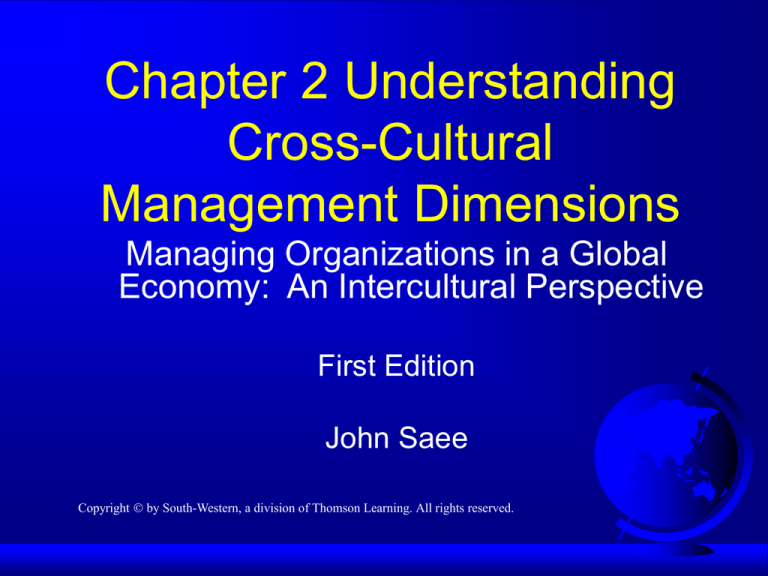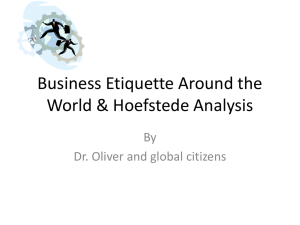
Chapter 2 Understanding
Cross-Cultural
Management Dimensions
Managing Organizations in a Global
Economy: An Intercultural Perspective
First Edition
John Saee
Copyright by South-Western, a division of Thomson Learning. All rights reserved.
Global Strategy and Culture
To succeed, corporations must develop
global strategies. Recent decades saw
the growing importance of global
strategies, at least among leading firms
and management scholars; however, the
new millenium made it imperative
(Adler 1997).
Cross–Cultural
Management
The growing importance of world
business has created a demand for
managers sophisticated in global
management skills and working with
people from other countries.
Cross–cultural
management describes
organizational behavior within countries
and cultures; compares organizational
behavior across countries and cultures;
and seeks to understand how to improve
the interaction of co–workers, managers,
executives, clients, suppliers, and
alliance partners from around the world.
Parochialism
Global
versus Domestic Organizations
Two fundamental differences between
global and domestic organization are
geographic dispersion and
multiculturalism.
Multiculturalism means that people from
many cultures interact regularly.
What
Is Culture?
To understand the differences between
domestic and global management, it is
necessary to understand the primary ways
in which cultures around the world vary.
Culture
is:
Something that is shared by all or almost
all members of some social group.
Something that the older members of the
group try to pass on to the younger
members.
Something that shapes behavior or
structures one’s perceptions of the world.
Cultural
Orientations
The cultural orientation of the
society reflects the complex
interaction of values, attitudes, and
behaviors displayed by its members.
Individuals express culture and its
normative qualities through the
values that they hold about life and
the world around them (Adler 1997)
How
Do Cultures Vary
As shown in Table 1, six basic dimensions
describe the cultural orientation of
societies: people’s qualities as individuals,
their relationship to nature and the world,
their relationship to other people, their
primary type of activity, and their
orientation in space and time.
Table 1. Values Orientation Dimensions
Perception
of
Dimensions
Individual
Good
Good and Evil
Evil
World
Dominant Harmony
Subjugation
Human
Individual Laterally
Hierarchical
Relations
Extended Groups Groups
Activity
Doing
Controlling
Being
Time
Future
Present
Past
Space
Private
Mixed
Public
The six dimensions answer the questions
Who am I?
How do I see the world?
How do I relate to other people?
What do I do?
How do I use space and time?
How
People See Themselves
People’s
Relationship to the World
What is a person’s relationship to the
world? Are people dominant over their
environment, in harmony with it, or
subjugated by it?
Personal
Relationships: Individualism
or Collectivism
Activity:
Doing or Being
North Americans generally see
themselves as dominant over nature.
Other societies, such as Chinese and
Navaho, attempt to live in harmony
with nature. They see no real
separation between people and their
natural environment.
Work Behavior Varies Across
Cultures
Worldwide Differences in Managerial
Style
Andre Laurent (INSEAD, France)
studied the philosophies and behavior of
managers in nine Western European
countries, the U.S., and three Asian
countries (Indonesia, Japan, and the
People’s Republic of China). He found
distinct patterns for managers in each of
the countries.
Task
“The
and Relationship
main reasons for a hierarchical
structure is so that everybody knows
who has authority over whom.”
“In
order to have efficient work
relationships, it is often necessary to
bypass the hierarchical line.”
Managers: Experts or Problem
Solvers?
Laurent found little agreement across
national borders on the nature of the
managerial role.
Another
related study by England
(1986) found that employees’ work
goals/motivation varied across
cultures.
Table 3: Comparative Work Goals: German,
Japanese, and American Respondents’ Rankings
Work goals
Interesting work
Good pay
Good interpersonal
relations
Good job security
A good match between you
and your job
A lot of autonomy
Opportunity to learn
A lot variety
Convenient work hours
Good physical working
conditions
Promotion
Source: England (1986, P. 181)
Germany
3
1
Japan
2
5
USA
1
2
4
2
6
4
7
3
5
8
9
6
6
1
3
7
9
8
4
8
5
6
9
11
10
10
11
11
10
In
another international study of
management–performance appraisals
in the U.S.A., Saudi Arabia, and Japan
conducted by Harris and Moran
(1991), it was found that performance
appraisal differed significantly across
cultures.
A seminal
research by Hofstede (1980)
went further in showing how the
underlying values of the cultures
across the world permeate through to
affect relationships, work, and social
values.
Hofstede
(1980) undertook a
comprehensive study on worldwide
sociocultural factors influencing
management. Hofstede’s research
compared work–related attitudes
across a range of cultures. From his
survey of 116,000 employees in 40
countries, Hofstede isolated 4 major
dimensions which were congruent with
different cultural values of specific
countries. These socio–cultural factors
were:
1.Collectivism vs. Individualism
2.Small vs. Large Power Distance
3.Weak vs. Strong Uncertainty Avoidance
4.Femininity vs. Masculinity
Fifth Cultural Dimension
Hofstede, in collaboration with Bond
(1984), identified an additional cultural
dimension by which nations can be
classified: Confucian Dynamism.
Confucian Dynamism is also referred
to as Long Term Orientation vs. Short
Term Orientation.
Confucianism
is not a religion, but a
system of practical ethics prevalent in
China.
The five basic relationships are:
Ruler–subject
Father–son
Older brother–younger brother
Husband–wife
Older friend–younger friend.
The junior owes the senior respect, and
the senior owes the junior protection and
consideration. The prototype for all
social institutions is the family. A
person is mainly a member of a family,
as opposed to being just an individual.
Harmony in the family must be
preserved, and harmony is the
maintenance of one’s face, that is, one’s
dignity, self respect, and prestige.
Treating others as one would like to be
treated oneself is virtuous behavior.
Skills for Effective CrossCultural Management
Respect.
Tolerating ambiguity.
Skills for Effective CrossCultural Management
Relating to people.
Skills for Effective CrossCultural Management
Being nonjudgmental.
Skills for Effective CrossCultural Management
Personalizing one’s observations.
Skills for Effective CrossCultural Management
Empathy—the ability to “put
yourself in another’s shoes.”
Skills for Effective CrossCultural Management
Persistence.








